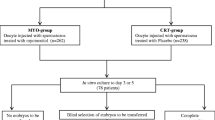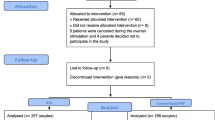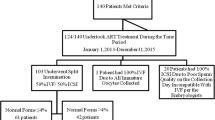Abstract
Purpose
To evaluate whether the deposition of the spermatozoon in the human oocyte at ICSI has any effect on oocyte survival, fertilization, blastocyst development and quality.
Methods
In a prospective study, including 78 ICSI cycles, sibling oocytes were injected with “no intention” (group A, standard ICSI, n = 393) or “intention” to deposit the spermatozoon under the cortex (group B, n = 354). Outcome parameters were oocyte survival and fertilization, as well as blastocyst formation and quality.
Results
Depositing the sperm under the cortex of the oocyte was not always successful for its final position, therefore, group B was divided into three subgroups: B1 successful deposition (119 oocytes, 33.6 % of oocytes in group B); B2 initially successful but spermatozoon spontaneously relocated after 2 min (136 oocytes, 38.4 %); and B3 unsuccessful deposition (99 oocytes, 28.0 %). Group A and B were compared on an intention-to-treat basis. Additionally, A, B1, B2 and B3 were also compared. The oocyte survival and fertilization, blastocyst and top-quality blastocyst developmental rates were not significantly different.
Conclusions
The procedure of depositing the spermatozoon intentionally under the oocyte cortex demanded high technical skills. Successful positioning was only obtained in 34 % of the attempts. We obtained no evidence of improved oocyte survival and fertilization, blastocyst formation and quality when the spermatozoon was permanently positioned under the oocyte cortex. Taken together, depositing the spermatozoon under the oocyte cortex is not recommended for routine ICSI application.
Similar content being viewed by others
References
Ahlström A, Westin C, Reismer E, Wikland M, Hardarson T. Trophectoderm morphology: an important parameter for predicting live birth after single blastocyst transfer. Hum Reprod. 2011;26:3289–96.
Ajduk A, Zernicka-Goetz M. Quality control of embryo development. Mol Asp Med. 2013;34:903–18.
Ajduk A, Ilozue T, Windsor S, Yu Y, Seres KB, Bomphrey RJ, et al. Rhythmic actomyosin-driven contractions induced by sperm entry predict mammalian embryo viability. Nat Commun. 2011;2:417–26.
Blake M, Garrisi J, Tomkin G, Cohen J. Sperm deposition site during ICSI affects fertilization and development. Fertil Steril. 2000;73:31–7.
Dozortsev D, Rybouchkin A, De Sutter P, Dhont M. Sperm plasma membrane damage prior to intracytoplasmic sperm injection: a necessary conditon for sperm nucleus decondensation. Hum Reprod. 1995;10:2960–5.
Dozortsev D, Qian C, Ermilov A, Rybouchkin A, De Sutter P, Dhont M. Sperm-associated oocyte activating factor is released from the spermatozoon within 30 minutes after injection as a result of the sperm-oocyte interaction. Hum Reprod. 1997;12:2792–6.
Ducibella T, Fissore R. The roles of Ca2+, downstream protein kinases, and oscillatory signaling in regulating fertilization and the activation of development. Dev Biol. 2008;315:257–77.
Ebner T, Moser M, Sommergruber M, Puchner M, Wiesinger R, Tews G. Developmental competence of oocytes showing increased cytoplasmic viscosity. Hum Reprod. 2003;18:1294–8.
Gardner DK, Schoolcraft WB. Culture and transfer of human blastocysts. Curr Opin Obstet Gynecol. 1999;11:307–11.
Grasa P, Coward K, Young C, Parrington J. The pattern of localization of the putative oocyte activation factor, phospholipase C zeta, in uncapacitated, capacitated, and ionophore-treated human spermatozoa. Hum Reprod. 2008;23:2513–22.
Gray D, Plusa B, Piotrowska K, Na J, Tom B, Glover DM, et al. First cleavage of the mouse embryo responds to change in egg shape at fertilization. Curr Biol. 2004;14:397–405.
Hardarson T, Lundin K, Hamberger L. The position of the metaphase II spindle cannot be predicted by the location of the first polar body in the human oocyte. Hum Reprod. 2000;15:1372–6.
Joris H, Nagy Z, Van de Velde H, De Vos A, Van Steirteghem A. Intracytoplasmic sperm injection: laboratory set-up and injection procedure. Hum Reprod. 1998;13 Suppl 1:76–86.
Kolibianakis EM, Zikopoulos K, Verpoest W, Camus M, Joris H, Van Steirteghem AC, et al. Should we advise patients undergoing IVF to start a cycle leading to a day 3 or day 5 transfer? Hum Reprod. 2004;19:2550–4.
Mizuno K, Hoshi K, Huang T. Fertilization and embryo development in a mouse ICSI model using human and mouse sperm after immobilization in polyvinylpyrrolidone. Hum Reprod. 2002;17:2350–5.
Nagy ZP, Liu J, Joris H, Bocken G, Desmet B, Van Ranst H, et al. The influence of the site of sperm deposition and mode of oolemma breakage at intracytoplasmic sperm injection of fertilization and embryo developmental rates. Hum Reprod. 1995;10:3171–7.
Palermo G, Joris H, Devroey P, Van Steirteghem A. Pregnancies after intracytoplasmic sperm injection of singe spermatozoon into an oocyte. Lancet. 1992;340:17–8.
Papanikolaou EG, D’haeseleer E, Verheyen G, Van de Velde H, Camus M, Van Steirteghem A, et al. Live birth rate is significantly higher after blastocyst transfer than after cleavage-stage embryo transfer when at least four embryos are available on day 3 of embryo culture. A randomized study. Hum Reprod. 2005;20:3198–203.
Papanikolaou EG, Camus M, Kolibianakis EM, Van Landuyt L, Van Steirteghem A, Devroey P. In vitro fertilization with single blastocyst-stage versus cleavage stage embryos. N Engl J Med. 2006;354:1139–46.
Payne D, Flaherty S, Barry MF, Matthews CD. Prelimanary observations on polar body extrusion and pronuclear formation in human oocytes using time-lapse video cinematography. Hum Reprod. 1997;12:532–41.
Piotrowska-Nitsche K, Chan AWS. Effect of sperm entry on blastocyst development after in vitro fertilization and intracytoplasmic sperm injection - mouse model. J Assist Reprod Genet. 2013;30:81–9.
Sathananthan AH, Selvaraj K, Girijahankar ML, Ganesh V, Selvaraj P, Trounson AO. From oogonia to mature oocytes: inactivation of the maternal centrosome in humans. Microsc Res Tech. 2006;69:396–407.
Saunders CM, Larman MG, Parrington J, Cox LJ, Royse J, Blayney LM, et al. PLC zeta: a sperm-specific trigger of Ca2+ oscillations in eggs and embryo development. Development. 2002;129:3533–44.
Steptoe PC, Edwards RG. Birth after reimplantation of a human embryo. Lancet. 1978;2:366.
Stoddart NR, Fleming SD. Orientation of the first polar body of the oocyte at 6 or 12 o’clock during ICSI does not affect clinical outcome. Hum Reprod. 2000;15:1580–5.
Swann K, Windsor S, Campbell K, Elgmati K, Nomikos M, Zernicka-Goetz M, et al. Phospholipase C-ζ-induced Ca2+ oscillations cause coincident cytoplasmic movements in human oocytes that failed to fertilize after intracytoplasmic sperm injection. Fertil Steril. 2012;97:742–7.
Taylor CT, Lawrence YM, Kingsland CR, Biljan MM, Cuthbertson KSR. Oscillations in intracellular free calcium induced by spermatozoa in human oocytes at fertilization. Hum Reprod. 1993;8:2174–9.
Tesarik J, Sousa M, Testart J. Human oocyte activation after intracytoplasmic sperm injection. Hum Reprod. 1994;9:511–8.
Van Der Westerlaken LA, Helmerhorst FM, Hermans J, Naaktgeboren N. Intracytoplasmic sperm injection: position of the polar body affects pregnancy rate. Hum Reprod. 1999;14:2565–9.
Van Landuyt L, De Vos A, Joris H, Verheyen G, Devroey P, Van Steirteghem A. Blastocyst formation in in vitro fertilization versus intracytopasmic sperm injection: influence of the fertilization procedure. Fertil Steril. 2005;83:1397–403.
Van Steirteghem AC, Nagy Z, Joris H, Liu J, Staessen C, Smitz J, et al. High fertilization and implantation rates after intracytoplasmic sperm injection. Hum Reprod. 1993;8:1061–6.
Woodward BJ, Montgomery SJ, Hartshorne GM, Campbell KH, Kennedy R. Spindle position assessment prior to ICSI does not benefit fertilization or early embryo quality. Reprod Biomed Online. 2008;16:232–8.
Yanaihara A, Iwasaki S, Negishi M, Takashi O. Sperm retention site and its influence on cleavage rate and early development following intracytoplasmic sperm injection. J Assist Reprod Genet. 2006;23:63–7.
Yoshida N, Perry ACF. Piezo-actuated mouse Intracytoplasmic Sperm Injection (ICSI). Nat Protoc. 2007;2:296–304.
Zegers-Hochschild F, Nygren KN, Adamson GD, de Mouzon J, Lancaster P, Mansour R, et al. The ICMART glossary on ART terminology. Hum Reprod. 2006;21:1968–70.
Acknowledgments
The authors wish to thank the laboratory, clinical and paramedical team of the Centre for Reproductive Medicine.
Conflict of interest
The authors declare that they have no conflict of interest.
Author information
Authors and Affiliations
Corresponding author
Additional information
Capsule
Spermatozoon deposition under the human oocyte cortex at ICSI did not improve oocyte survival and fertilization, nor blastocyst formation and quality.
Rights and permissions
About this article
Cite this article
De Vos, A., Abraham, M., Franceus, N. et al. Deposition of the spermatozoon in the human oocyte at ICSI: impact on oocyte survival, fertilization and blastocyst formation. J Assist Reprod Genet 32, 865–871 (2015). https://doi.org/10.1007/s10815-015-0482-6
Received:
Accepted:
Published:
Issue Date:
DOI: https://doi.org/10.1007/s10815-015-0482-6




